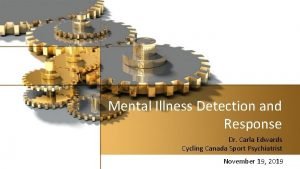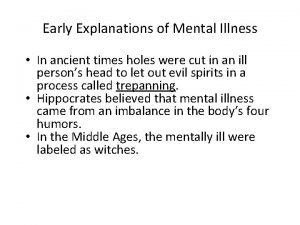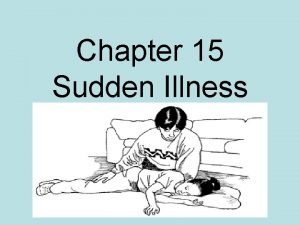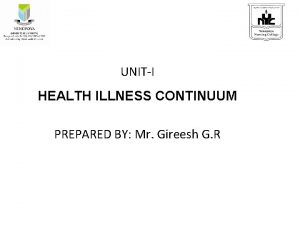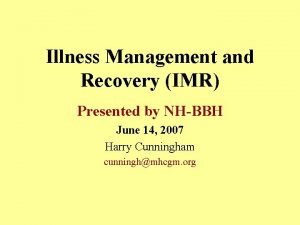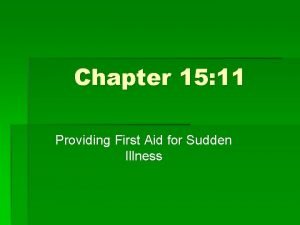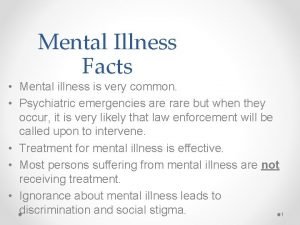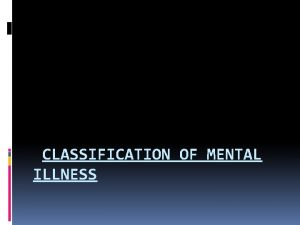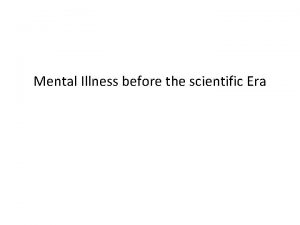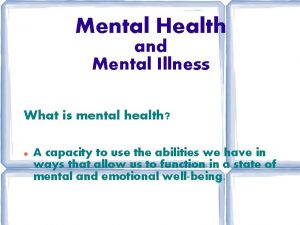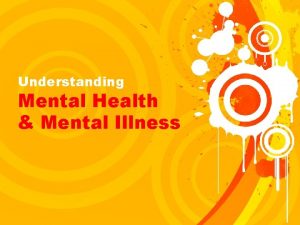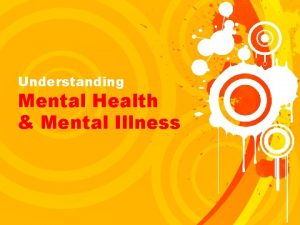Mental Illness Detection and Response Dr Carla Edwards




























- Slides: 28

Mental Illness Detection and Response Dr. Carla Edwards Cycling Canada Sport Psychiatrist November 19, 2019

Prelude • It is important to recognize the athlete first as a person- not just a performance machine • Engaging the athlete on a personal level and learning how to best motivate them to achieve their peak performance (which will vary between athletes) will lead to better performance, sport satisfaction, and overall wellbeing • Athletes are very resilient individuals who can manage a remarkable amount of stress.

When Struggles Happen • • Mental illness can occur in athletes at the same rates as the general population Athlete performance and behavior can change throughout the season, and may present as: Tardiness Missed training Declining performance Increased errors Underperformance Irritability, anger, fatigue, impaired concentration, social isolation, impaired stress management – Anxiety attacks, tearfulness – Significant weight loss or gain – – –

Contributing Factors • The factors underlying these changes are multifactorial, and may include: – – – – Lengthy travelling Over training Challenges created by housing situation Conflict with teammate(s) or coach(es) Academic stress Financial difficulty Physical illness or injury Family stress Lifestyle management issues (sleep, nutrition, balancing schedule) Loss (grief) Trauma (physical/sexual/psychological)- potentially from a sport context Transitions (planning for life after major games, not being selected for teams, awaiting “promotion” to the elite squads, retirement) Mental illness

Identify the Signs, Understand What They Mean • If you see signs of psychological and emotional struggles or hear athletes talking about their difficulties, you are not expected to be their counselors or therapists • You need to be aware of resources that are available to them and danger signs to watch for • Signs of emotional and psychological struggle can include: – – – Evidence of self-harm (obvious scars or recent cuts, inappropriate use of long sleeves and evasive behaviour) Increased drinking or drug use Change in behaviour around training- late for training, missed training or competitions; avoidance of, or frequent requests for, anthropometric measures (particularly in leanness or endurance sports) Excessive distraction or emotional reactivity that is out of character (sadness, irritability, anger) Rapid changes in sleep and eating routines, which impact energy, attendance, and performance Sudden changes in socialization with the team; increased isolation Tearfulness Panic attacks Changes in personal hygiene and appearance Talking a lot about problems and feelings Others express concern about the athlete

Identify the Signs, Understand What They Mean • Some athletes may be just dealing with mild challenges that can be managed with a review of needs directly with them and some enhanced supports • Some athletes may require more intensive intervention and support. It is important to identify them early, and then get help in determining where they go from there.

Specific Challenges • • • Performance-based Mood disorders Anxiety disorders Sleep disorders ADHD Eating Disorders Substance Use Disorders PTSD Self-harm Post-concussion mental illness

Your role(s) • Coaches can play a pivotal role in recognition, support, and management of treatment. This can be facilitated through open dialogue with the athletes, checking in with the athletes at appropriate times, and incorporating management of their needs into the team approach (ie travel times and arrangements, and an open, accepting culture for mental wellness). • It is important to be aware of the support network that is available for athletes- including sport psychiatrists, mental performance consultants, psychologists, sport medicine physicians, family doctors, and crisis services.

Your role(s) • While it is important to recognize the signs of struggle, it is equally important to recognize your roles as supporter, advocate, and linkage to supports. Your roles do NOT include therapist, counselor, or doctor

Know the risks! • Low: No risk of harm to self or others; distress is limited to one area of athlete’s life • IST role: Express concern and provide personal support by listening carefully; suggest that athlete reaches out to support (or you can reach out to supports)- this can include Carla (cedwards@synergysportmentalhealth. ca; 905 -5705629) and Fiona (Fiona. meikle@cyclingcanada. ca; 289228 -7616) (response will be 12 -24 h later)

Know the risks! • Medium: Unclear if there is a risk of harm to self or others; no immediate risk but athlete is currently in distress and it may escalate • IST role: Express concern and provide personal support by listening carefully. Reach out to Carla and Fiona, also connect with local resource (Dr. Rod Corban- 642 -1941765; rod. corban@gmail. com)

Know the risks! • High: Threat of violence or harm to self or others (safety risk for the athlete or for others). Direct or indirect reference to suicide; acute distress affecting the athlete’s ability to function. • IST role: express your concern for the athlete. Contact local resources; call 111 (emergency services in NZ) for acute risk

Resources • Mental Performance Consultant: Fiona Meikle - Fiona. meikle@cyclingcanada. ca; 289 -2287616 • Sport Psychiatrist: Dr. Carla Edwards- cedwards@synergysportmentalhealth. ca; 905 -570 -5629 • Local Sport Psychologist (NZ): Dr. Rod Corban- rod. corban@gmail. com; 642 -194 -1765 • Emergency services (NZ)- 111

Building Resilience Fiona Meikle

Put Your Own Oxygen Mask on First

Under pressure, leadership strengths can become weaknesses • Drive for results unrealistic perfectionism and criticism • Good relationships unwillingness to confront problem behaviour • Self confidence burnout through never asking for help • Dilligent worker drive self and others into the ground • Fast pace Mistakes through sloppy thinking The question is not “Do I change under stress? ”. . . but “HOW do I change under stress? ”

What influences YOUR ability to cope? Response to Pressure is Influenced by: Thoughts/Thinking Emotions/Feelings • Expectations (Realistic? Helpful? ) “be the best we can be on the day” • Perceptions (How bad is it? Do you think you/your team can cope? ) • Your confidence in coping • How well you manage your emotions Body/Physical Feeling • • • Your health Sleep Nutrition Blood pressure Tension Behaviour/Doing • Your ability to Control the Controllables • Your determination to thrive

What can you do? Know Your Warning Signs. . . when pressure gets to you, how do you respond?

What can you do? Know Your Warning Signs. . . when pressure gets to you, how do you respond? What do you typically THINK or SAY? What EMOTIONS do you typically FEEL? How does your BODY respond? How do you BEHAVE? What do you typically do? Which do you tend to notice first? If you can recognise the warning signs, you can change your response!

What can you do? Keep your armour strong – Quality sleep (bring earplugs, sleep mask, headphones) – Nutrition (bring cool bags and zip lock bags of snacks) – Know your needs for personal space – Take 5 minutes to relax (so you can bounce back quickly) - Headspace – Exercise – Manage your expectations

What can you do? Use Your Support Network • Communicate your needs • Ask for help • Talk to the support staff – Your Team • Talk to friends/family • Buddy system

What can you do? Know how your response to stress impacts other staff & athletes • • • Respect the needs of others Have a pressure release valve Let others’ frustrations slide off you Ask for feedback about your behaviour Communicate

What can you do? Preparation, Preparation “Peak performance is truly about learning to be comfortable being uncomfortable. ” – Dr. Ken Ravizza

What can you do? (The ABC’s) Beliefs Responses • People are disturbed not by things, but by their rigid and extreme views of things (Reformulation of Epictetus AD 55 -135) • Facts stay the same • Meaning we give to facts can differ Adversity… (The POOP hits the fan) Self-Defeating Belief Mentally Tough Belief Unhealthy Negative Emotions & Negative Consequences Healthy Negative Emotions Leading to Problem Solving & Better Consequences

What can you do? Check Your Responses • Ask yourself…. Is my response helpful? If it’s not, choose to change your response!!


q Know your warning signs q Choose a refocus trigger q Keep your armour strong q Focus on the positives q Focus on what you can control q Prioritise q Use your support network q Help your team mates q Expect the Unexpected – Be Flexible q Check your responses (mentally tough or destructive) q Start practicing your thriving attitude NOW!

Any questions?
 Chapter 20 mental health and mental illness
Chapter 20 mental health and mental illness Mental health coping skills jeopardy
Mental health coping skills jeopardy Dr carla edwards
Dr carla edwards Historical views of mental illness psychology ocr
Historical views of mental illness psychology ocr Fair housing act mental illness
Fair housing act mental illness Mental illness in ancient times
Mental illness in ancient times Axis 1 and axis 2 disorders
Axis 1 and axis 2 disorders Mark rothko mental illness
Mark rothko mental illness Catherine earnshaw mental illness
Catherine earnshaw mental illness Americanization of mental illness
Americanization of mental illness Derealiation
Derealiation Ksi mental illness
Ksi mental illness Natural and forced response
Natural and forced response Natural response and forced response example
Natural response and forced response example Primary immune response and secondary immune response
Primary immune response and secondary immune response What are sudden illnesses
What are sudden illnesses Define health illness continuum
Define health illness continuum Illness and wellness continuum
Illness and wellness continuum Define health illness continuum
Define health illness continuum Nhbbh
Nhbbh Verbo afirmativo em inglês
Verbo afirmativo em inglês Topgunauditschool.com
Topgunauditschool.com Food borne illness poster
Food borne illness poster In times of illness na
In times of illness na Foodborne illness vocabulary
Foodborne illness vocabulary Foodborne illness
Foodborne illness Stages of heat illness
Stages of heat illness 17.10 providing first aid for specific injuries
17.10 providing first aid for specific injuries Chapter 15:1 providing first aid
Chapter 15:1 providing first aid


